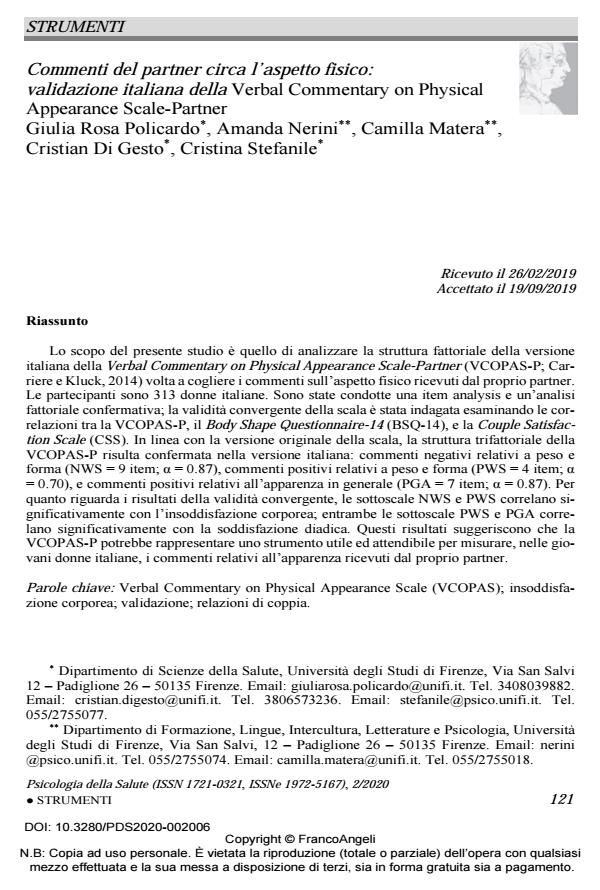Appearance commentary by partner: Italian validation of Verbal Commentary on Physical Appearance Scale-Partner
Journal title PSICOLOGIA DELLA SALUTE
Author/s Giulia Rosa Policardo, Amanda Nerini, Camilla Matera, Cristian Di Gesto, Cristina Stefanile
Publishing Year 2020 Issue 2020/2
Language Italian Pages 19 P. 121-139 File size 755 KB
DOI 10.3280/PDS2020-002006
DOI is like a bar code for intellectual property: to have more infomation
click here
Below, you can see the article first page
If you want to buy this article in PDF format, you can do it, following the instructions to buy download credits

FrancoAngeli is member of Publishers International Linking Association, Inc (PILA), a not-for-profit association which run the CrossRef service enabling links to and from online scholarly content.
The aim of the present study was to investigate the factor structure of the Italian version of the Verbal Commentary on Physical Appearance Scale-Partner (VCOPAS-P; Carriere e Kluck, 2014), which assesses comments on physical appearance received from one’s partner. The participants were 313 Italian women. Item analysis and confirmatory factor analysis were performed; the convergent validity of the scale was tested by examining correlations between the VCOPAS-P and both the Body Shape Questionnaire-14 (BSQ-14) and the Couple Satis-faction Scale (CSS). In line with the original version of the scale, the trifactorial structure of VCOPAS-P was confirmed in the Italian version: Negative Weight and Shape (NWS = 9 item; α = 0.87), Positive Weight and Shape (PWS = 4 item; a= 0.70), Positive General Ap-pearance Subscale (PGA = 7 item; a= 0.87). With regard to convergent validity, the NWS and PWS subscales significantly correlated with body dissatisfaction; both PWS and PGA subscales significantly correlated with dyadic satisfaction. These findings suggest that the VCOPAS-P can be a useful and reliable instrument for the measure of the comments on phys-ical appearance received from one’s partner among Italian women.
Keywords: Verbal Commentary on Physical Appearance Scale (VCOPAS); body dissatisfac-tion; validation; couple relationship.
- The Power of Words: Appearance Comments from One’s Partner Can Affect Men’s Body Image and Women’s Couple Relationship Elena Fornaini, Camilla Matera, Amanda Nerini, Giulia Rosa Policardo, Cristian Di Gesto, in International Journal of Environmental Research and Public Health /2021 pp.9319
DOI: 10.3390/ijerph18179319
Giulia Rosa Policardo, Amanda Nerini, Camilla Matera, Cristian Di Gesto, Cristina Stefanile, Commenti del partner circa l’aspetto fisico: validazione italiana della Verbal Commentary on Physical Appearance Scale-Partner in "PSICOLOGIA DELLA SALUTE" 2/2020, pp 121-139, DOI: 10.3280/PDS2020-002006